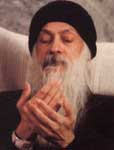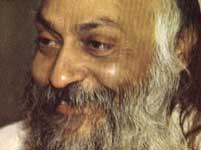

Osho was born in 1931 to a Jain family as Rajneesh Chandra Mohan in Kuchwara, a town in central India. He claims to have waited 800 years to find parents of sufficient purity for him to take human birth, having already sought enlightenment at the feet of many great Masters in previous lives. (Whatever the merits of this claim it is of interest to see that the parents of great Masters may be significant, for example both parents of Ramakrishna had a presentiment of his spiritual greatness, as did the mother of Krishnamurti, to say nothing of Mary mother of Jesus). As a child Osho was unruly and adventurous. His main early influence was his beloved grandfather, whose death was a terrible blow to the young child. Characteristic of the young Osho's temperament was his leadership of a gang of boys, inspiring them with daredevil acts such as diving from great heights into rivers and whirlpools, or from a bridge guarded by a policeman to prevent suicides. Osho was self-confident and sometimes aggressive, particularly if he thought that his rights had been ignored.
Despite a rather basic early schooling Osho studied philosophy at Jabalpur University, where he received his BA degree in 1955, and where he later taught. He also attended the University of Saugar and obtained an MA in 1957. He taught until the force of his spiritual illuminations led him to the life of spiritual Master. Osho claims that every seven years he went through a spiritual crisis, the first being on the loss of his grandfather, and the second at the age of fourteen when he felt, somewhat like Ramana, that he was going to die. Taking leave from school for a few days he found an almost deserted temple in the mountains and laid down, as if to die, or to be reborn in some as yet unknown way. Eventually a snake made its way over his body, and Osho thought that this would be the turning point : life or death. The snake passed on its way and the youth felt that a new life had been given him. His interest in all things spiritual continued and in 1953 at the age of twenty-one after seven days of intensive spiritual search he was enlightened under a tree in a local park.
Osho began an intensive teaching itinerary, commenting once that he had been his own 'John the Baptist' to prepare India for his later teachings. This period of exhausting travel ended when he settled firstly in Bombay and then in Koragaon Park in Pune (Poona), where an ashram was founded around him, and he acquired the honorifics 'Bhagwan' and 'Shree'. As Bhagwan Shree Rajneesh he taught to ever-increasing crowds of followers, initiating those who chose it into 'neo-sannyas', which involved the wearing of orange robes and a 'mala' or necklace bearing his picture, and the taking of an Indian name. Despite his provocative teachings he had a significant number of Indian followers, but the bulk of his disciples were Westerners.
Before long he had an international following with 'Rajneesh Centres' in many major cities around the world, where books and tapes were sold and visitors could participate in a number of the meditations he had devised, many of which included dancing or chaotic movement and breathing. Osho had little interest or patience in convention and was under pressure from the Indian government for tax irregularities. In 1981 he moved his commune to a large ranch bought for the ashram in Oregon USA, and proceeded to create an alternative society partially based on the Israeli kibbutz system. They turned the unproductive ranch into fertile farmland, combining an intense spiritual practice with long hours of manual labour. As the project grew the community wanted to incorporate their settlement as a city, a move that alarmed local residents, and hostilities grew between the two communities. The ashram leader, a woman called Ma Anand Sheela, was eventually accused of plotting to poison local residents, interfering with the democratic process and even of plotting to kill the district attorney. Osho (as he had become known in this period) had spent some years in silence, so it is debatable as to his role in the events that led to the collapse of the commune, but he was arrested and charged with falsely arranging marriages. While in prison Osho claims that he was poisoned by the authorities with thallium, and on his eventual deportation and return to India his health deteriorated. He died in 1990, at the age of 59, and in intense pain. The ashram claim that his early death was due to thallium poisoning, citing similarities with the mysterious death of a anti-nuclear civil rights campaigner who had been imprisoned in the same jail in the US as Osho.
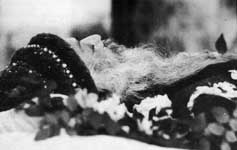
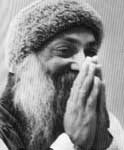
Osho's teachings centred on awareness and a love of life. For many years he spoke for one and a half hours a day, and while he was in India he alternated on a monthly basis between the English and Hindi languages. The transcripts of his talks appear in almost five hundred volumes, which include book series on the great spiritual teachers of the world. His ten-volume translation and commentary on the Yoga Sutras of Patanjali are typical of his early discourses, combining his own translation from the Sanskrit original with lengthy commentary, interspersed with jokes. The breadth of his reading was remarkable, perhaps only approached by Douglas Harding amongst the Masters presented here (as we saw Krishnamurti took no interest at all in the teachings of others, and is reputed to have read mainly detective novels). Osho's eclecticism gave him a universality of mind, but makes it hard to pin down his own teachings.
Awareness is a common theme however, in particular the 'double-edged arrow of awareness' that G.I.Gurdjieff taught (or 'double-barbed' as Douglas Harding called it, quite independently). Osho was greatly influenced by Gurdjieff in his approach to teaching, believing that the mind-feeling-body continuum benefited from 'shocks' that helped stimulate awareness and wake up the dormant spiritual side. These ideas were put into practice in a series of meditations that Osho devised, and in workshops or 'groups' that became the mainstay of practice for visitors to the ashram and centres round the world. Osho adopted many psychotherapeutic techniques that were in vogue in the seventies, and, in keeping with the doctrines of sexual liberation of that time, encouraged sexual experimentation as part of spiritual practice. He drew heavily on Hindu and Buddhist Tantric sources for guidance on the use of sex in the pursuit of transcendence, and it is for this that he is mainly infamous now. Few seemed to have noticed how often he spoke of transcending sex, implicit for example in the title one of his early books From Sex to Superconsciousness. His approach was to go through sex rather than suppress it, but his goal was nevertheless its transcendence.
Osho also emphasised the master/disciple relationship, which he saw as a kind of love affair. He thought it unlikely that an aspirant could gain enlightenment from his discourses in printed form (however insightful they may have been), often stressing that it was his presence, or the 'silence between the words' where the real work took place. This was a quite traditional view of the role of guru, in the East at least, but for many of his Western followers it may have been their first exposure to the idea.
His embrace of the breadth of life, in opposition to traditional views of renunciation, found a simple formula in his three 'M's --- Music, Mathematics, and Meditation, standing respectively for the arts, science/technology, and the spiritual. He felt that to neglect any one of these three areas was to become narrow or even one-dimensional, and in the modern era it was absurd to turn one's back on the delight and creativity of the arts, or the knowledge and living standards that science and technology could bring. Accordingly, life in the ashram involved the arts, the creation of beautiful buildings and gardens, and the use of modern technology where appropriate. For Osho, transcendence meant to embrace everything that life had to offer, rather than to shut down the senses and dull the mind.
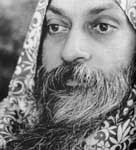
Osho was an iconoclast. While Krishnamurti ignored Indian spiritual traditions (and all other spiritual traditions for that matter), and spoke out against the guru principle, he did not otherwise set out to destroy tradition. In contrast Osho was convinced that the ancient spiritual traditions of India (in particular) were in themselves an obstacle to spiritual progress. His main target was the concept of renunciation, which he saw as responsible not only for the material poverty of India, but for the serious, if not rather grim, face of religion. His vision of the spiritual life was that it should be light, joyous and full of humour, rather than serious, sorrowful and moralising. Although he had immense respect for Ramana Maharshi and Sri Ramakrishna, he saw their renunciative stance as part of a past that should be overthrown, and his chosen method was to take the ancient symbol of renunciation, the ochre robe, and turn it into a symbol of the 'new man'. His followers, called 'neo-sannyasins', were to retain the inner spiritual life of the renunciate, but embrace and celebrate every aspect of the physical life, including sex. His target was conventional Hindu society, and the orange-robed Westerners flaunting their sexual and material wealth achieved his purpose of shocking conservative Hindus. His own symbolic revolt against renunciation included the wearing of expensive clothes and watches, and the gradual accumulation of 92 Rolls-Royces.
The events in Oregon leading to the expulsion of the movement and Osho's death are considered by many to undermine or negate anything of value in Osho's teachings. A neutral and critical appraisal of Osho's legacy is long overdue, as most commentators seem to have drawn on a single book for negative material, The God Who Failed, by Hugh Milne. Such an appraisal will have to wait, but what is of importance here is the implication of Osho's experiment for via positiva.
Osho attempted a revolution in spiritual thinking, to integrate the spirituality of a Ramana or Ramakrishna, with a love of life. He called his ideal composite 'Zorba the Buddha' after a novel about a Greek man with an exuberant lifestyle. As such it is worthy of consideration, all the more because Osho also recognised the importance of the jnani / bhakti distinction. While Whitman is the great guru of via positiva, he has been largely ignored, and even Osho was not aware of his significance. Harding's via positiva is neutral about the world, which is there mainly to demonstrate our 'original face' or true nature. Krishnamurti saw the beauty of the natural world, perhaps mainly in an aesthetic sense, but Osho went much further in advocating a love of life in all its ramifications. The fact that his experiment 'failed' in the eyes of most commentators has left the world community of spiritual seekers wary of such an approach and more likely to succumb again to scepticism about life itself. This can be seen in the teachings of Andrew Cohen for example, whose emphasis on purity and moral values is a reaction to many of the teachers of the 1970s, who, like Osho, were experimenting with sexual openness and counter-culture ideas.
|
'Given that
many of Osho's followers seemed to have learned from him only the least
attractive of his qualities, noticeably a contempt for tradition and the
democratic process, the disaster in Oregon was inevitable. The real loss
is the devaluing of his teachings, which, as found in his books, audio
tapes, or videos, are a treasure-trove of spiritual insight.'
|
Osho's via positiva is contradictory or paradoxical however. In Oregon he spent several years in complete silence, one of the marks of the renunciative life he so criticised. He also lived a very simple life, in a small room, ate a vegetarian diet, and had no legal title to any ashram property or possessions. Paradox was part of his teachings, and he did not encourage attempts to distil his often contradictory remarks spread over some 500 volumes into a coherent and concise system of thought. He liked to enter deeply into the teachings of whoever his discourses focused on, and said that his ability to become a conduit for their teachings inevitably meant that there would be contradictions. There were common themes however, one being that the inner transformation of the individual from a divided and fearful personality into an enlightened being grounded in awareness could be described as the transition from an experience of the world as a chaos to the vision of it as a cosmos. This is a valuable clue to the via positiva, that its hallmark is a perception of the manifest world as profoundly and beautifully ordered. In contrast most beginners on the spiritual path are drawn to explore religious teachings because they feel that life is a chaos.
There is no doubt however that Osho left chaos behind him. He was influenced by G.I.Gurdjieff in his teaching methods, which included techniques for deliberately creating confusion in the disciple's life and mind in order to allow a new and more spontaneous order to arise. What he failed to take from Gurdjieff however was an extreme selectivity of pupil, allowing instead individuals with a range of vulnerabilities and personal problems to be exposed to his methods, often through senior ashram members, who were not necessarily gifted teachers. The desire to reach a large number of people also permitted power-hungry individuals to take control of the community. Given that many of his followers only seemed to have learned from him the least attractive of his qualities, noticeably a contempt for tradition and the democratic process, the disaster in Oregon was inevitable. The real loss is the devaluing of his teachings, which, as found in his books, audio tapes, or videos, are a treasure-trove of spiritual insight.
Osho does not deserve to be dismissed. His discourses are instructive in the positive sense as his mistakes are in the negative sense. Any new spiritual community is capable of the errors of Oregon. This is closely related to the unfortunate instinct of seekers to latch onto the apocalyptic and paranoid components of a teaching, even when these comprise a very small part, as in Osho's case.
